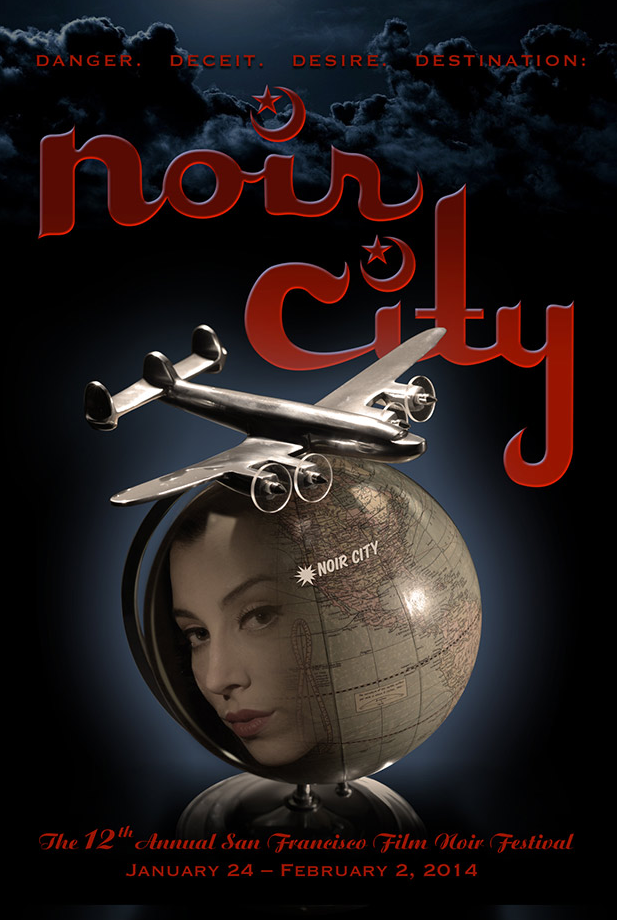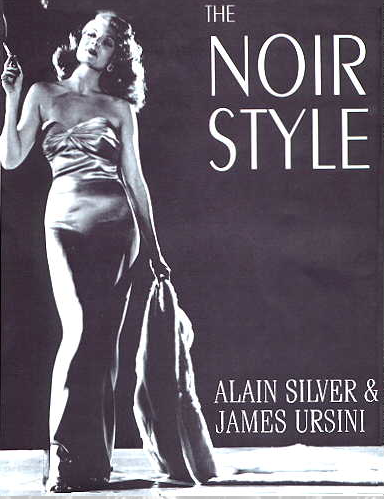The Old Guard Changes
Introduction
Many of the documents posted on filmnoirfile.com were written before some of the exponents of the film noir hardboiled paradigm began to show evidence of a shift away from the hardboiled paradigm. Of course, this evidence shouldn’t be interpreted to mean that these authors have repudiated the hardboiled paradigm. But it demonstrates that their perspective about film noir has broadened. And that’s an important start.
Below are some examples of before and after.
Presentation
In the third edition of Film Noir: An Encyclopedic Reference to the American Style (The Overlook Press, 1992), the editors, Alain Silver and Elizabeth Ward, stipulate, “The concept that the action of film noir must be grounded in a contemporary setting excludes Westerns and period films.” One of the key contributors to the book was James Ursini.
In 1999, Silver and Ursini produced one of the finest of all books on film noir, The Noir Style (The Overlook Press). The authors adhere to the the main tenets of the hardboiled paradigm, “The socio-cultural precedents for film noir are many and diverse…The usual suspects were and are German Expressionism and European émigrés who came to Hollywood to escape Nazism; hard-boiled fiction….”
However, in the selection of photographs it presents and analyzes, The Noir Style breaks the commandment in the third edition of Film Noir by including examples of “period films,” such as Hangover Square (1945), Moss Rose (1947), Experiment Perilous (1944), Gaslight (1944). Furthermore, there are many women’s noirs that are “contemporary” (i.e., set in the 1940s-50s) .
Before Silver, Ward, Ursini, and Robert Porfirio published Film Noir: The Encyclopedia (Overlook Duckworth, 2010), it was referred to as the “fourth edition” of Film Noir: An Encyclopedic Reference to the American Style. The critical difference between the third and “fourth” editions is the rejection of the stipulation against acknowledging westerns and period films as film noir. There is no mention of this rejection in the new book, but there are at least 10 westerns and more than a dozen period films. In addition, there are more contemporary women’s noirs than in the third edition.
You will look in vain through Eddie Muller’s book, Dark City: The Lost World of Film Noir (St. Martin’s Press, 1998) for photographs (much less text) about film noirs that are not set in 1940s-50s urban America. Even the chapter titles pertain to geographic locations within his dark city (“Vixenville,” “Knockover Square,” etc.). In Muller’s conception of film noir, the “lost world” has no period films or women in distress. (See the page Women’s Noirs in Hardboiled Books).
Foster Hirsch’s Film Noir: The Dark Side of the Screen (DaCapo Press, 1981, second edition, 2008) provides the same pictorial and textual representation of film noir as solely sited in a mid-century urban jungle. (For more about how Hirsch’s perspective of the “literary background” of film noir represents the hardboiled paradigm, and how I have challenged it, see the page Published Sources: Women’s Noirs.)
However, Muller and Hirsch are two more of the old guard who have changed. Take the January 2008 issue of The Sentinel, Muller’s original 4-page, black and white e-zine from the Film Noir Foundation. (Each issue of the FNF’s current e-zine, Noir City, is more than 100 pages in vivid color.) A front page article is entitled, “When Is Noir Not Noir?” It says:
“Consider these iconic noir tableaux: a frantic Richard Widmark running down shadow-streaked alleyways; a dying Edmond O’Brien stalking his murderer through the famous Bradbury building; Charles McGraw decked out in a 16th century French soldier’s uniform, brandishing a cutlass.
“Huh?
“If that last one threw you for a loop, be forewarned: The Film Noir Foundation will be screening several films during its 6th annual Noir City festival — Hangover Square, Reign of Terror, The Suspect, Moonrise, Face Behind the Mask — that don’t fit comfortably into the classic mid-20th century urban noir milieu.
“Is it possible for a movie set in 16th-century France or post-Victorian era England to still be considered film noir?
“Absolutely, according to Noir City 6 producer/host and FNF President Eddie Muller: ‘Crime stories are timeless, as old as the Bible. True noir tells these tales from the perpetrator’s perspective. So why discount a story as non-noir just because it’s set in Victorian England or the Los Angeles of the future?
“This perspective on noir is not out of focus, according to esteemed film historian and author Foster Hirsch, who remarks that, ‘The definition of noir is extremely fluid.’ According to Hirsch, certain films, while lacking the familiar noir attributes, are nonetheless ‘noir-stained.’
“According to Muller, the essential ingredients of noir are the characters. ‘Although they feel ‘gothic,’ I find Hangover Square and Face Behind the Mask as noir as anything written by Jim Thompson. It’s what’s in the heads of the characters that counts, not the clothes they wear.”
The reader of this article may be forgiven for being taken aback (Huh?) that there could be a film noir in which Charles McGraw brandishes a cutlass while decked out in a 16th century French soldier’s uniform. Forgiven because the old guard, like Muller and Hirsch, helped establish the hardboiled paradigm, which didn’t include period films as film noir.
Don Malcolm posted his interpretation of Repeat Performance on the website The Blackboard on New Year’s Eve, 2006. Using his “noir-o-meter” for the noir element of “a fall guy,” he gave Joan Leslie a full 5 points out of 5. (For his appraisal, see the page of Repeat Performance & Noir-O-Meter.) In my rebuttal, I showed why Leslie’s character was a woman in distress. (For my response to Malcolm’s post, see the page Repeat Performance vs. Hardboiled.)
Less than a year and a half later, Malcolm, the managing editor of The Sentinel, had a front page article in the March/April 2008 issue of the e-zine entitled, “Heroines in Noir: Beyond the Femme Fatale.” He cites several types of women who are not femmes fatales, such as, “The Long-Suffering Type” and “Wrinkles in Distress.” For each category, he provides the titles of film noirs and the names of the female characters who represent the type. Way beyond continuing to call her “a fall guy,” Malcolm re-interprets Joan Leslie’s character in Repeat Performance as a “Redeemer in Distress.”
There is a long way to go. Some film noir festivals have broadened their range of offerings so that the films screened conform more to the diversity of film noirs found in reference books. This diversity, of course, contradicts the narrow range of film noirs that would be scheduled based on the first three editions of Silver and Ward’s Film Noir, Hirsch’s Film Noir, and Muller’s Dark City.
Also, as I discuss on other pages (such as Hollywood Heroines and Woman in Distress vs. Femme Fatale), there are a few academic books that challenge tenets of the hardboiled paradigm.
The movement is in the right direction, toward abandoning the film noir hardboiled paradigm.
Addendum

Another — and very welcome — example of the old guard changing is the focus on foreign film noirs at the 12th. annual NOIR CITY festival in San Francisco, January 14 – February 2, 2014.
The difference in programming from past festivals is described in the Fall 2013 issue of the Film Noir Foundation’s e-zine, Dark City. (The FNF sponsors NOIR CITY.)
The 12th edition of the world’s most popular film noir festival is going international, exploding the long-held belief that noir stories and style are a specifically American phenomenon. Focusing on the years immediately following World War II, this year’s NOIR CITY festival features classic noir films from France, Mexico, Japan, Argentina, Germany, Spain, Norway, and Britain, as well as a complementary sampling of homegrown Hollywood product. Familiar American stars such as Robert Mitchum, Ava Gardner, Orson Welles, Dan Duryea, and Lizabeth Scott will share the Castro Theater screen with international superstars Jean Gabin, María Félix, Toshiro Mifune, Ninón Sevilla, and Yves Montand. The 27 films in the series will conclusively prove that the cinematic movement known as “Noir” spanned the globe, and its style, sexiness, and cynicism crossed all international borders.
Our desire to expand the scope of the festival has resulted in our most ambitious program ever,” said festival impresario and host Eddie Muller. “Its overall impact will, I suspect, change many people’s long-standing ethnocentric preconceptions about film noir.”
Of course, “many people’s long-standing ethnocentric preconceptions about film noir” have been reinforced by the previous eleven NOIR CITY festivals and the offshoots of this annual event in other cities around the country.
Furthermore, with a growing library of books and DVDs that explicitly identify foreign film noirs, it is historically inaccurate to claim that the 12th. NOIR CITY is responsible for “exploding the long-held belief that noir stories and style are a specifically American phenomenon.”
Such unwarranted boasting aside, the new approach to programming the festival is better late than never. It is evidence that a significant tenet of the film noir hardboiled paradigm has been jettisoned.
